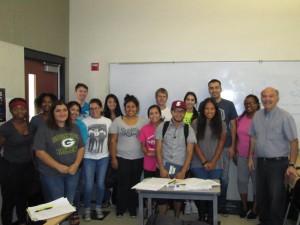Lucie Ekezyan
Staff Writer

Photo: ASP Archive
Fresno State offers many cultural classes and among these are courses offered by the Armenian Studies Program, which explore Armenian history, the art inspired by it, and the language that defined it. Since its inception in the 1960’s, more than a thousand students from diverse backgrounds have learned elementary Armenian language skills: speaking, writing, and reading.
For the past thirty-one years, the language courses have been taught by Prof. Barlow Der Mugrdechian, who himself took Armenian language classes at Fresno State. He remembers how the language classes he took influenced him.
“I had always had a desire to improve my Armenian language skills as a way to communicate with my grandparents, who were Genocide survivors,” said Der Mugrdechian. “But I discovered so much more about Armenian culture and history, and began to understand the central role that the Armenian language had in the development of the Armenian people.”
Some twenty students entered the Armenian 1A course in August to begin a sixteen-week experience with the language. They came from backgrounds reflecting Fresno State’s own diversity. They also came with diverse expectations and motivations.
Armenian 1A serves as one of several introductory courses to a Minor in Armenian Studies, and students often have their first exposure to the Armenian culture by taking the language course. Armenian 1A also fulfills the Area C2 Breadth requirement in the area of Humanities, thus students earn units satisfying both General Education and the requirements for a Minor in Armenian Studies.
While all the students who enrolled have the desire to learn the language, the paths that led them to the class are unique
Amber Galvan, who is new to the culture and eager to learn, has enrolled in both Armenian 1A and Armenian Studies 10 this semester. “I took the Armenian course to learn how to speak a new language. I really like the letters since they’re so different, and I like passing by the Genocide Monument and actually understanding the Armenian words on it and realizing that I am one of the few students that knows what they mean,” said Galvan.
A number of students found that of the required courses in Area C2, Armenian 1A was the most interesting. “Most people take Spanish or French, but I wanted to take something different. It’s an interesting class. I hope to understand and communicate in Armenian,” said junior Glenda Davis.
Others wanted to learn their second or third language. Among them is senior Victoria Tinoco, who stated, “It’s exciting! We’re moving very fast and we were speaking Armenian the very first day. I hope to be able to communicate with other beginners or native speakers.”
Sophomore Jesus Lopez is learning his third language and is “glad to be in the class.” He enjoys learning about the culture and also learning to speak and write Armenian.
Even students with Armenian backgrounds had different reasons for enrolling in the course. “I want to be able to take part in simple conversations in Armenian at church and with family,” said sophomore Marina Chardukian.
Senior Bagrad Oganyan is taking the course to “strengthen [his] reading and writing skills and to be able to read [his] Bible in Armenian.”
For Prof. Der Mugrdechian, the opportunity to teach Armenian to a diverse classroom is a challenge that he has enjoyed for many years, and he enjoys imparting the Armenian culture to those who would like to learn the Armenian language.
 Hye Sharzhoom Armenian Action
Hye Sharzhoom Armenian Action